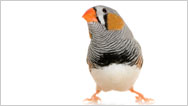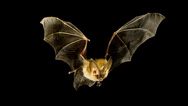The Mysteries of Optic Flow
- Posted 04.10.14
- NOVA
How do birds manage to fly through narrow spaces without constantly bumping into trees or buildings? It turns out that they use a trick of the eye called optic flow. Understanding what optic flow is and how birds use it could help us build a safer world for our feathered friends.
Transcript
The Mysteries of Optic Flow
Posted: April 10, 2014
When you see a bird zipping easily through the trees or landing gracefully on a tiny telephone wire, it can seem like it’s performing a great acrobatic feat. Just how does it pull off those complicated maneuvers at such high speeds?
It turns out that birds rely on a trick of the eye that even humans can perform: they’re using something called “optic flow.” Optic flow is the way our eyes perceive motion as we travel through a landscape. For example, it’s the illusion that trees and buildings are passing us by as we drive down a city street. The greater the optic flow, the faster things appear to be moving.
Along with his colleagues at the Queensland Brain Institute, Partha Bhagavatula, then a graduate student at the Australian National University, performed a series of experiments testing how birds take advantage of optic flow. First they trained a bird to fly through a narrow corridor with either horizontal or vertical lines painted on the walls. A recreation, shown here, was performed by a starling, though they originally used a budgie. Flying by the vertical lines should give the appearance of more movement, creating greater optic flow. In both cases, the birds wound up flying straight down the center of the corridor, but when the lines were vertical, they flew slower, indicating that they adjusted their speed based on the amount of motion they perceived.
The scientists then had the birds fly through a corridor with one vertical wall and one horizontal wall. In this case, the birds didn’t fly straight down the middle of the corridor—instead, they flew closer to the wall with the horizontal stripes. But why? It turns out that flying farther away from the vertical stripes decreased the apparent speed on that side. So the scientists think that in order to avoid collisions, birds try to keep the same amount of optic flow in both their eyes.
But the researchers didn’t stop there. They then had the birds fly through yet another corridor, this time with one vertical wall and one completely blank wall. The birds still steered clear of the striped wall, but this time so much so that they occasionally collided with the blank one!
The results of these experiments show that birds use optic flow to fine-tune their navigation when maneuvering at high speeds. Understanding how birds make these delicate modifications could have major implications in the real world. It could help us understand how to build better flight navigation systems for manmade flying machines. Or, it could help us build structures, like wind turbines and skyscrapers, that are more visible to birds so they can keep on soaring.
Credits
PRODUCTION CREDITS
- Narrated by
- Anna Rothschild
- Original Footage
- © WGBH Educational Foundation 2014
MEDIA CREDITS
- Experimental Footage
- Partha Bhagavatula et al, ANU/QBI
- Starling on wires
- ©Pond5/Excitator
- Wind Turbines 4
- ©Pond5/Unlimited_Stock_Media
- Driving Through European City
- ©Pond5/ActiveStock
- Bird In Forest
- ©Pond5/SimonDando
- File: Quadcopter 01.JPG
- Wikimedia Commons/Zeynel Cebeci (CC BY 3.0)
- Music: Moonlight Hall
- Incompetech/Kevin MacLeod (CC BY 3.0)
IMAGE
- (main image: Bird Flying)
- © WGBH Educational Foundation 2014
Sources
Bhagavatula, Partha S. et al. 2011. "Optic Flow Cues Guide Flight in Birds" Current Biology Volume 21, Issue 21: 1794 - 1799. http://www.cell.com/current-biology/abstract/S0960-9822(11)01010-4
Neuroscience of Vision and Aerial Robotics, The University of Queensland, The Queensland Brain Institute
http://web.qbi.uq.edu.au/srini-lab/index.php?page=res_birds&ss=2
Wylie, D.R.W., W.F. Bischof, B.J. Frost. 1998. "Common reference frame for neural coding of translational and rotational optic flow" Nature Volume 392: 278-282. http://www.nature.com/nature/journal/v392/n6673/full/392278a0.html
Srinivasan, Mandyam V., Shaowu Zhang. 2004. "VISUAL MOTOR COMPUTATIONS IN INSECTS" Annual Review of Neuroscience Volume 27: 679-696. http://www.annualreviews.org/doi/abs/10.1146/annurev.neuro.27.070203.144343
Related Links
-

Inside Animal Minds
In this series, go inside the brains of three smart animals—dogs, birds, and dolphins.
-

Bird Brains
Clues to the origins of human language are turning up in the brains of birds.
-

Profile: Irene Pepperberg & Alex
One woman's 30-year relationship with an African gray parrot transformed our understanding of bird intelligence.
-

Seeing With Sound
Future bio-inspired technologies could help the blind community echolocate like bats.

